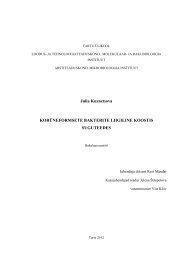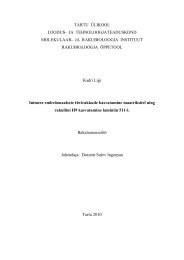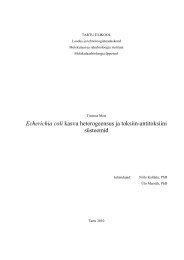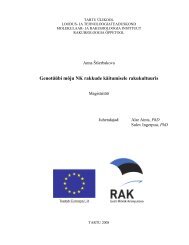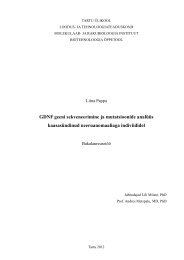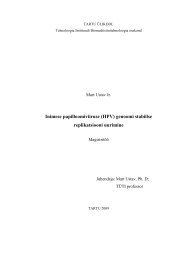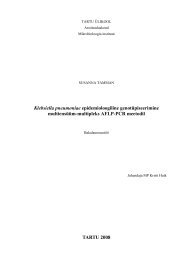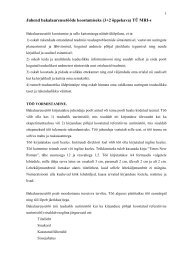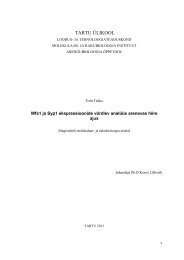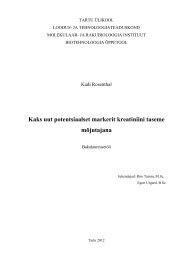Maternal variation in Huichol and Mixtec populations from Mexico
Maternal variation in Huichol and Mixtec populations from Mexico
Maternal variation in Huichol and Mixtec populations from Mexico
You also want an ePaper? Increase the reach of your titles
YUMPU automatically turns print PDFs into web optimized ePapers that Google loves.
the def<strong>in</strong><strong>in</strong>g transition at nps 1243. The <strong>Huichol</strong> haplotype has a reversion at position 1243,<br />
but accord<strong>in</strong>g to the nps at 15629 <strong>and</strong> 16241, it is positioned to belong to C4c1a subclade of<br />
C4a1 subhaplogroup. It also has unique SNP at 9938 position <strong>and</strong> a transversion at nps 11861.<br />
The coalescent age estimates for C4c <strong>and</strong> C4c1 haplogroups were calculated by Rho (ρ)<br />
statistics. The calculations were performed on all substitutions exclud<strong>in</strong>g the 16182C,<br />
16183C, 16194C <strong>and</strong> 16519 mutations. Mutational distances were converted <strong>in</strong>to years us<strong>in</strong>g<br />
the corrected molecular clock proposed by Soares et al., (2009).<br />
The average distance (ρ) of the haplotypes <strong>from</strong> the root of C4c haplogroup was 5,059 with<br />
the st<strong>and</strong>ard error (σ) of 1,1. This corresponds to a divergence time of 13,500 ± 5,900 years<br />
accord<strong>in</strong>g to Soares et al., 2009. The estimated time for C4c1, with ρ=3,84 <strong>and</strong> σ=0,8,<br />
corresponds to a divergence time of 10,200 ± 4,300 years.<br />
The determ<strong>in</strong>ation of a founder micro-haplogroup C4c <strong>in</strong> the Central American population<br />
can lead to several conclusions. The distribution pattern of two m<strong>in</strong>or-haplogroups X2a <strong>and</strong><br />
C4c is very similar (especially <strong>in</strong> comparison with D4h3), except the presence of two<br />
Columbian C4c <strong>and</strong> one newly determ<strong>in</strong>ed Mexican C4c samples south <strong>from</strong> United States.<br />
The coalescence ages of both X2a <strong>and</strong> C4c founders are also similar, which supports the idea<br />
that these two l<strong>in</strong>eages arrived together <strong>from</strong> the Ber<strong>in</strong>gia through ice-free corridor after LGM<br />
(Hooshiar Kashani et al., 2011; Perego et al., 2009). The frequencies of C4c <strong>and</strong> X2a<br />
nowadays are very low. Because the C4c frequency <strong>in</strong> an ancient Oneota site <strong>in</strong> Western<br />
Ill<strong>in</strong>ois could have reached ~8,3% (Stone <strong>and</strong> Stonek<strong>in</strong>g, 1998), it is possible that the<br />
frequencies of X2a <strong>and</strong> C4c might be higher, <strong>and</strong> their geographic distribution could have<br />
been wider than today (Hooshiar Kashani et al., 2011). Because of the mtDNA sensibility to<br />
genetic drift, it is possible that X2a l<strong>in</strong>eages were more widely spread, but have gone through<br />
ext<strong>in</strong>ction <strong>and</strong> X2a is not present <strong>and</strong> C4c is extremely rare <strong>in</strong> modern <strong>populations</strong> <strong>from</strong> south<br />
of the USA. However, X2a <strong>and</strong> C4a could also have gone through, at least partly, separate<br />
demographic events.<br />
The newly sequenced <strong>Huichol</strong> belongs to C4c1a subclade (def<strong>in</strong><strong>in</strong>g mutations 15629 <strong>and</strong><br />
16241) together with three Cherokee <strong>from</strong> North Carol<strong>in</strong>a <strong>and</strong> Oklahoma (Figure 10). This<br />
shows that <strong>Huichol</strong> is more closely connected with the North America than with the South<br />
America, as it is previously described for Mexican Native Americans (S<strong>and</strong>oval et al., 2009).<br />
However, <strong>Huichol</strong> sample differs <strong>from</strong> them by its unique mutations: 1243 reversion, SNP at<br />
30



